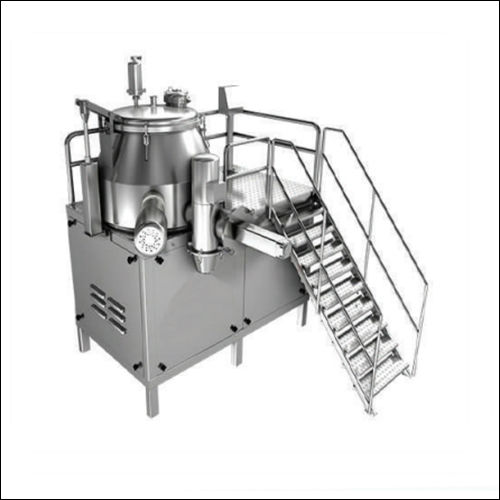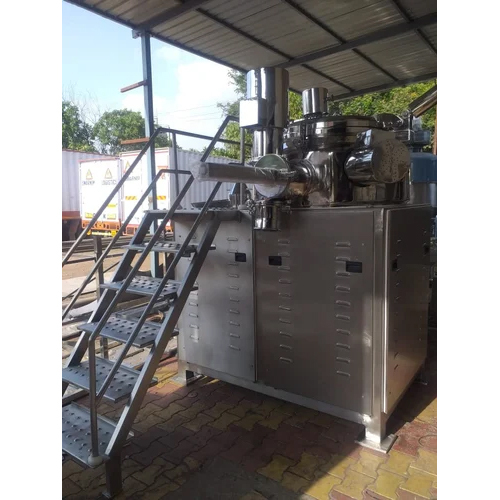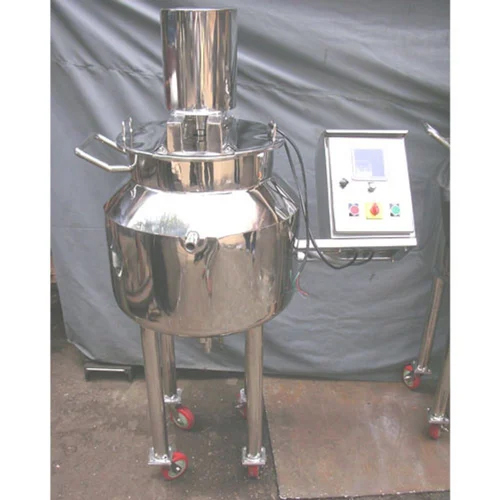Rapid Mixer Granulator
Price 250000 INR/ Unit
Rapid Mixer Granulator Specification
- Type
- Rapid Mixer Granulator
- Material
- Stainless Steel
- Capacity
- 3-800 Liter/day
- Computerized
- No
- Control Mode
- Automatic
- Voltage
- 230 Volt (v)
- Color
- Gray
Rapid Mixer Granulator Trade Information
- Minimum Order Quantity
- 1 Unit
- Supply Ability
- 1 Unit Per Week
- Delivery Time
- 1 Week
About Rapid Mixer Granulator
Versatile and Durable Construction
This Rapid Mixer Granulator stands out due to its stainless steel build, offering exceptional durability and resistance to corrosion. Its gray exterior not only complements industrial environments but also ensures longevity, making it a reliable choice for businesses looking for long-term equipment solutions.
Automated Control for Efficient Operation
Featuring a fully automatic control mode, this granulator streamlines the mixing and granulation process. By removing the need for manual intervention, the system enhances productivity and consistency in blending, vital for industries demanding high-quality output.
Wide Capacity Range for Diverse Applications
With processing capabilities from 3 to 800 liters per day, the granulator caters to both small batches and large-scale operations. This flexibility makes it suitable for a wide variety of industries including pharmaceuticals, food processing, and chemicals, supporting both research and production needs.
FAQs of Rapid Mixer Granulator:
Q: How does the Rapid Mixer Granulator work in industrial processes?
A: The Rapid Mixer Granulator employs high-speed mixing blades to blend powders uniformly and facilitate rapid granulation. This process combines dry ingredients with liquid binders under controlled agitation, resulting in homogenous granules suitable for further processing.Q: What materials are suitable for use with this granulator?
A: Thanks to its stainless steel construction, the granulator can handle a range of powders including pharmaceutical ingredients, food additives, and various chemicals. Its robust design ensures compatibility with both fine and coarse materials.Q: When should I choose a capacity between 3 to 800 liters per day?
A: Select the appropriate capacity based on your production scale. Lower capacities are ideal for research, pilot batches, or specialty productions, while higher capacities suit large-scale, continuous manufacturing environments.Q: Where can I purchase or source this Rapid Mixer Granulator in India?
A: The granulator is available through authorized dealers, distributors, exporters, manufacturers, and other industry professionals across India. Many suppliers can also offer after-sales support and installation services.Q: What is the typical process cycle for granulation in this machine?
A: A typical batch involves loading dry powders, adding a binder solution, mixing under high-speed agitation, and discharging the granulated mixture. The automatic control ensures consistent cycles with minimal operator intervention.Q: How do users benefit from the automatic, non-computerized control mode?
A: Operators benefit from streamlined processes as the machine automates critical stages, reducing manual workload. The non-computerized controls are user-friendly and reliable, minimizing the risk of software issues and easing maintenance.

Price:
- 50
- 100
- 200
- 250
- 500
- 1000+
More Products in Pharma Machineries Category
Stainless Steel Vibro Sifter
Price 78000 INR / Piece
Minimum Order Quantity : 1 Piece
Color : Silver
Type : Other
Material : Stainless steel
Control Mode : Automatic
SS Packing Conveyor
Price 240000 INR / Piece
Minimum Order Quantity : 1 Piece
Color : Silver
Type : Other, SS Packing Conveyor
Material : Stainless steel
Control Mode : Automatic
Rapid Mixer Granulator Machine
Price 1800000 INR / Piece
Minimum Order Quantity : 1 Piece
Color : Silver
Type : Other, Rapid Mixer Granulator Machine
Material : Stainless steel
Control Mode : Automatic
Stainless Steel Tank With Stirrer
Price 58000 INR / Piece
Minimum Order Quantity : 1 Piece
Color : Silver
Type : Other, Stainless Steel Tank With Stirrer
Material : Stainless steel
Control Mode : Automatic

 Send Inquiry
Send Inquiry





